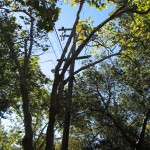The ABC’s of Undergrounding
What mechanisms and funding sources are available to Piedmont for undergrounding its utilities?
Undergrounding may be accomplished in a number of ways – through a city-wide undergrounding program using various sources of funding, or through three different types of undergrounding districts funded by homeowners privately and/or PG&E monies.
The ABC’s of Undergrounding
There are three types of undergrounding utility assessment districts available: 20A, 20B, and 20C.
20A Districts: 20A funds are provided by PG&E to the City of Piedmont through a requirement in the Public Utility Code which annually sets aside a portion of PG&E revenue for each utility jurisdiction. 20A funds are restricted in use and intended for undergrounding arterial streets. Primary arterial streets such as Highland Avenue, Grand Avenue, and the Civic Center block of Vista were completed using 20A funds. In the 1980’s the Piedmont City Council designated all of the City’s 20A funds for undergrounding Grand, Moraga, and Oakland Avenues. The undergrounding of Grand Avenue was completed and paid for using 20A funds. The undergrounding of Moraga and Oakland Avenues has not yet been accomplished. After 2002, the City Council changed its policy and began the practice of using 20A funds to assist private undergrounding (20B) projects – specifically, the Piedmont Hills, Central Piedmont, and Sea View Avenue Undergrounding Districts.
Details: July 2, 2007 minutes, at page 3-4; July 7, 2007 staff Report, p. 3. May 7, 2007 staff report, p. 3; May 7, 2007 minutes;
20B Districts: Dudley, Wildwood/Crocker, Piedmont Hills and Hampton-Sea View Undergrounding Districts are all examples of 20B districts. These districts, which are private, are normally funded through property assessments on the homes within the district. An engineer determines the formula for apportioning total costs between homeowners. A vote of the homeowners in the proposed district is held before the City Council can approve the creation of a 20B District. If the district receives an affirmative vote from homeowners paying at least 50% of the total assessment, the City Council may approve it. However, the Council may choose to require a higher level of support than 50% – for instance, 60% or 70% – before allowing the district to proceed forward. The level of homeowner support which the Piedmont Council should demand before approving a 20B district has been a matter of intense dispute. Once a district is approved by both the homeowners and the City, the City issues bonds and administers the contract for undergrounding the streets.
20C Districts: These are smaller, simpler districts than 20Bs, but funded through private property assessments, as well. King Avenue may have used this process. 20Cs enjoy a fast-track procedural process (compared to 20Bs). All undergrounding work is completed directly through PG&E, without any involvement by the City of Piedmont. 20Cs are normally formed by small groups of ten to twenty homeowners who all agree that they wish to underground. The homeowners decide among themselves on a fair apportionment of total cost (not an engineer). They often choose to simply divide the cost equally. The City does not issue any bonds and does not administer the undergrounding contract.
Undergrounding Property Assessments: Property assessments for private undergrounding districts are not tax-deductible, although they are billed through the county and appear on the homeowner’s property tax statement. The assessment will typically range from $20,000 to $55,000 per parcel. With 20B districts, homeowners are normally provided with the choice of paying the initial assessment immediately, in cash, or paying over a 25 year period with added interest (generally about 6%) and an added City administration fee (12%). (Supplemental assessments, if necessary, may or may not offer a payment option.)
In addition to the assessment, each homeowner must pay for his own lateral line connecting his house to the main line. The cost of the homeowner’s lateral line generally runs an additional $4,000 to $15,000 per home, but has cost as much as $30,000 where rock is present. This cost may be required to be paid immediately.
Citywide undergrounding: A citywide undergrounding improvement program could be implemented using any of four mechanisms: general tax revenues, bonds, a parcel tax, or 20A funds from PG&E.
– General Funds: using general funds would be problematic as insufficient funds would be available.
– Bonds: A bond approved by Piedmont voters would represent borrowing the money to underground the entire city. The cost of the bonds would be a tax-deductible and included on homeowner tax statements.
– Parcel Tax: A parcel tax approved by Piedmont voters, also tax-deductible, would allow the undergrounding of a certain number of streets every year as funds became available.
– 20A Funds: Using 20A funds received from PG&E as they accumulate would make it possible to underground the City on a very, very long term basis.
Citywide programs vs districts: Whatever mechanism is used – a citywide program, private undergrounding districts, or 20A funds – Piedmont residents ultimately pay all the costs of undergrounding as homeowners, taxpayers, or PG&E customers. However, the choice will affect the timing of undergrounding particular streets. A citywide program would presumably prioritize streets based on safety, with primary streets being completed first. Private districts, on the other hand, underground streets based on homeowners’ ability and willingness to bear the cost. In addition, the city’s choice will affect the cost of undergrounding: using 20A funds is least expensive, citywide undergrounding more expensive, and private districts most expensive.
Details: PG&E Rule 20, Minutes of May 23, 2005, p. 6.



